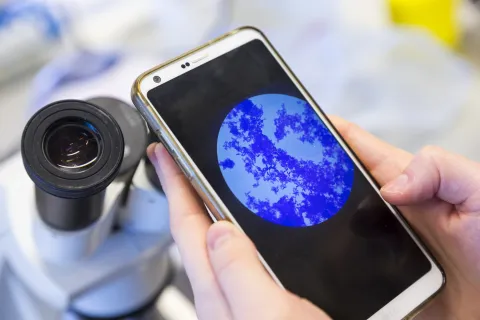
A team of scientists from a large number of different institutions that study Icelandic ecology are now involved in an extensive collaboration with the European Molecular Biology Laboratory (EMBL), aiming to shed new light on how organisms, from the smallest to the largest, respond to each other and to environmental changes. A pilot project planned for this summer will focus on coastal ecosystems in Iceland.The project is called TREC and is part of the EMBL's programme for the next five-year cycle, "Molecules to Ecosystems". The research theme is planetary biology and the aim is to harness the latest technology and methods in molecular biology to learn more about the status of individual ecosystems and the health of our planet.
Eiríkur Steingrímsson, professor of molecular biology at the UI Faculty of Medicine, has chaired the EMBL Council since 2020 and under his leadership the Council has worked towards the aforementioned goals. Zophonías Jónsson, professor of molecular biology at the UI Faculty of Life and Environmental Sciences, has also sat on the EMBL Council and Valerie Maier, project manager at the UI Biomedical Centre, has worked to adapt the programme to an Icelandic context.
"The programme was presented to Icelandic researchers and they were particularly interested in the planetary biology research theme, since it focuses on better understanding how microorganisms, algae, plants and animals respond to each other and changes in their natural environments," explains Eiríkur, adding that these topics will be explored on the molecular, cell, individual and population levels.
Research expedition to coastal regions of Iceland this summer
The EMBL operates at several sites across Europe and has been the organisation behind a large number of discoveries in molecular biology and genetics, many of which have been awarded the Nobel Prize. The EMBL is an organisation with a wealth of experience and knowledge, as well as first-rate facilities and equipment that will be used over the next years to shed new light on organisms, from the smallest to the largest, in different ecosystems.
There is also a rich tradition and extensive experience of ecological research at the University of Iceland and other Icelandic institutions. It was this that attracted the attention of the EMBL Director General, Edith Heard, and made her consider the coastal regions of Iceland for a kind of pilot project for TREC. "The idea is to carry out a research expedition along the coast of Iceland this summer, which will be a kind of precursor to larger expeditions in other coastal regions of Europe between 2023 and 2024," says Valerie.
The Icelandic expedition this summer will be used to collect samples and trial research methods. The expedition will be carried out by a team of around 15-20 scientists from Icelandic universities and institutions, united by a shared involvement in ecological research and monitoring. These institutions are: the Marine Research Institute, Matís, the Icelandic Institute of Natural History, the Icelandic Museum of Natural History, the University of Akureyri, Hólar University College and the Southwest Iceland Nature Research Centre, as well as the University of Iceland and UI research centres in the Westfjords and Suðurnes. These partners were also inspired to create a new network for scientists in this field, called BIODICE (https://biodice.is), which will work to promote research, greater awareness and understanding of biodiversity in Iceland. The idea behind this platform actually developed out of an online EMBL workshop for biologists. "Iceland is an ideal location to study ecology and biodiversity," says Valerie, explaining why Iceland was chosen for the pilot project.
